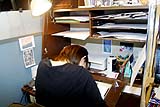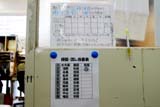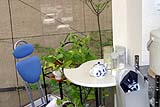Studio 1 Part 02: Working in Studio 1
Currently, there are 21 animators, 2 sequence directors and one production manager in Studio 1. Among the animators, 8 are key animators and 13 are inbetweeners. Five out of 13 inbetweeners are rookies; they are overseen one-on-one by five key animators, including Goto. "Actually, the method of inbetweening is evolving each year, so it might be better for experienced inbetweeners to look after these rookies. But to teach is a different thing; one needs to be generous and open minded to some extent. I mean, this will take up your time and you will be sacrificing some of your workload. So I thought it would be better for experienced key animators to take care of the rookies instead."
As for the inbetweens, there is an inbetween production department, which manages inbetweens for the entire house. They send over inbetween projects to each studio's inbetween managers (Reiko Sakai for Studio 1). Then Sakai will distribute work among the inbetweeners in the studio.
As for the key frame animation, all of the staff at Studio 1 discusses which project to tackle among the ongoing projects at I.G. Once they know which project they want, the production manager talks to each key animator to see how many frames they can handle. This amount is up to each animator to decide by him or herself.
"Studio 1 feels strongly that we all work on the same anime together. We all seem to think that that's one way of improving ourselves," says Studio 1 chief Takayuki Goto. When they work on the same project, they can visibly compare the pace and the quality of their work with each other, because they are sitting quite close to each other. That is a really good incentive to get better. And by working on one anime together as a team, they can guarantee the quality of their work to some extent. They really aim for a high level of accomplishment. This raises the professionalism of Studio 1 staff.
"Also, feature films and games require very high quality work that could only be handled by experienced key animators, and are not appropriate for training rookies. Whereas for the TV series, there are frames that we can leave up to the new key animators. If there is an animation supervisor among us, then he or she can oversee the new key animators. And also for the TV series, key frames for one episode must be completed within 2 to 3 weeks, so you get trained to work faster and you can also see your own frames on screen sooner. So when we were mainly working on feature films, we would seek TV series projects from other companies in order to train young people. Now that the key animators at Studio 1 are getting experienced, I don't think I have to be the animation supervisor every time we work on an anime. If the young people can handle it, then that's better. It's always a concern for me to see how each one of us can find a place to thrive in I.G and see how that could be done. For me, it's important that the staff stay with us. Creators are all selfish in a positive way and each one of them has his or her dream. Rather than me saying do this or do that to them, if we can participate and share the vision to do this or do that, then I think we can definitely share the feeling that we are building our company together," says Goto.
In 2004, Takayuki Goto and Kyoji Asano were working as animation supervisors for Ghost in the Shell: S.A.C. 2nd Gig; Toru Okubo and Toshiyuki Yahagi for Otogi Zoshi; and Yasutaka Kubota for Windy Tales all at the same time. They found a way to go in separate ways and still do their best, but it was expressed that the front-line staff truly wished to work together on one project if this was possible.








 terms of use
terms of use